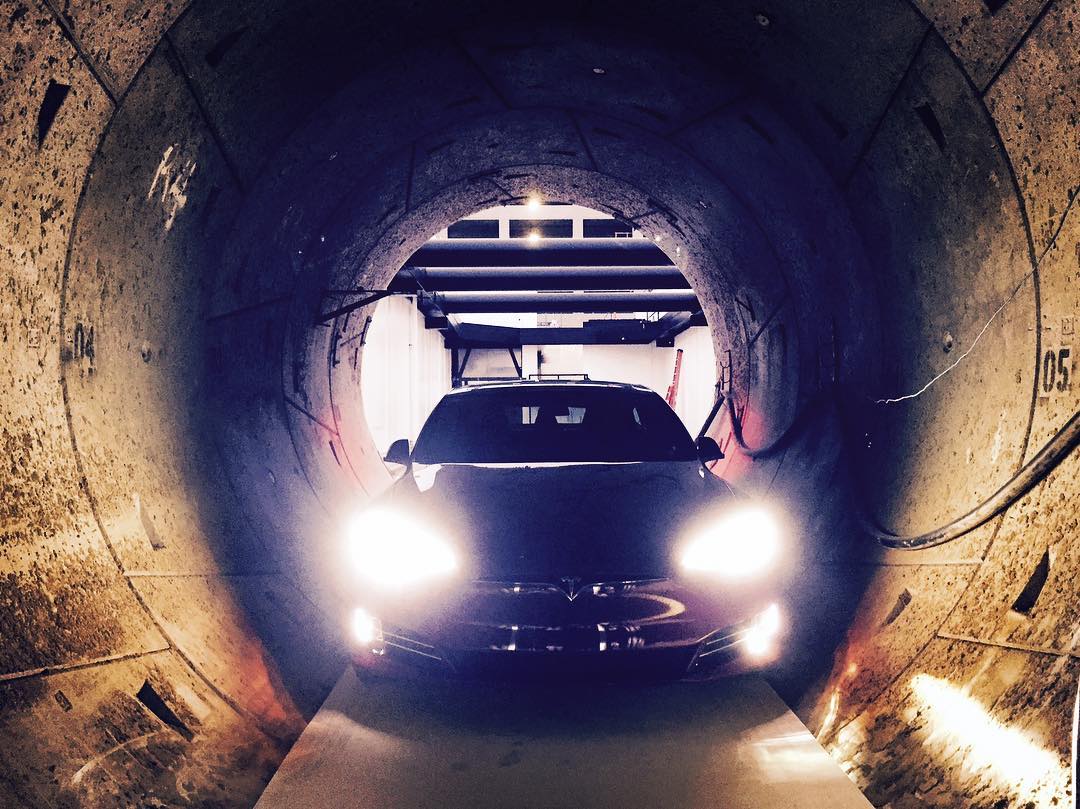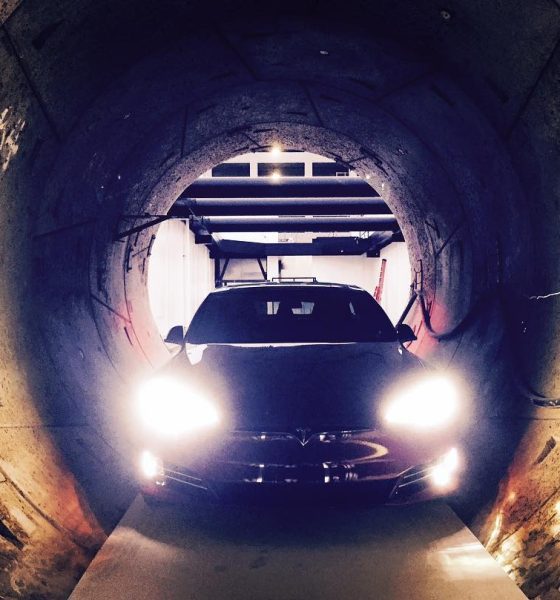

News
The Boring Company files permit to extend tunnel project in Los Angeles
Elon Musk’s The Boring company has filed a permit with Los Angeles to extend its tunnel project within city limits. A spokesperson for the Bureau of Engineering, Mary Nemick, confirmed the filing made by Musk’s tunnel digging venture though no further details were provided.
The Tesla and SpaceX CEO previously revealed plans to build an underground tunnel beginning near LAX airport and continue along the westside of Los Angeles, into the San Fernando valley. “First route will go roughly parallel to the 405 from LAX to 101, with on/offramps every mile or so. It will work like a fast freeway, where electric skates carrying vehicles and people on pods on the main artery travel at up to 150mph, and the skates switch to side tunnels to exit and enter.” said Musk.
Los Angeles Mayor Eric Garcetti, who’s historically been a big proponent of Musk and his projects, took to Twitter on Wednesday to welcome The Boring Company’s forward-thinking vision for the city’s transportation system. “Los Angeles has always been a place where innovators come to build new ideas that can change how we live our lives,” said Garcetti. “We look forward to continuing our conversations about this new transportation technology, and exploring the ways that it can help us build a better future for our city.”
If approved, the newly filed permit will allow Boring Co. to dig beyond the existing 2-mile test tunnel that’s currently being constructed beneath 120th street near SpaceX’s headquarters in Hawthorne, CA.
Hawthorne Mayor Alex Vargas said in August, after The Boring Company won city council approval for its tunneling project, “The city of Hawthorne is excited to see the rapid progress at which the tunnel is being completed, we are looking forward to seeing Elon Musk begin testing his system and making subterranean travel a reality here in our city.”
The company has been testing a prototype of an electric skate that will be used to transport vehicles at high speeds within a 13.5 foot diameter tunnel that’s located 44 feet below ground. According to documents submitted to the city council, “The test tunnel project would involve SpaceX engineers repeatedly testing personal vehicle types suitable for placement on the skates; refinement of the design and technology; and general data collection on performance, durability, and application,”
As The Boring Company awaits approval to extend its tunneling project into the westside of Los Angeles, Musk and team will continue to iterate on streamlining the process for tunnel building. Unlike traditional underground tunnels for passenger vehicles, Boring Co.’s tunnels will be smaller and able to maintain a vacuum in order to support Hyperloop transportation. Reducing the tunnel diameter by 50% will also reduce the cross sectional area of the tunnel by a factor of four. Musk noted in his speech at TED2017 that having a smaller tunnel just large enough for a vehicle will cut 75% of the time associated with digging, thereby introducing a significant cost savings. The Boring Company’s tunnel boring machine will also look to install tunnel walls continuously while it digs, thus eliminating the need to pause operations and speeding up the process entirely.
In addition to its project in California, the company received approval by Maryland officials to dig a 10.1-mile tunnel that aims to connect Baltimore with Washington, DC. Maryland Governor Larry Hogan said in a Facebook post on October 19, “Incredibly excited to announce our administration’s support for The Boring Company to bring rapid electric transportation technology to Maryland, connecting Baltimore City and Washington D.C.”

News
Tesla is seeing a lot of momentum from young Koreans in their 20s-30s: report
From January to November, young buyers purchased over 21,000 Teslas, putting it far ahead of fellow imported rivals like BMW and Mercedes-Benz.

Tesla has captured the hearts of South Korea’s 20s-30s demographic, emerging as the group’s top-selling imported car brand in 2025. From January to November, young buyers purchased over 21,000 Teslas, putting it far ahead of fellow imported rivals like BMW and Mercedes-Benz.
Industry experts cited by The Economist attributed this “Tesla frenzy” to fandom culture, where buyers prioritize the brand over traditional car attributes, similar to snapping up the latest iPhone.
Model Y dominates among young buyers
Data from the Korea Imported Automobile Association showed that Tesla sold 21,757 vehicles to the 20s-30s demographic through November, compared to BMW’s 13,666 and Mercedes-Benz’s 6,983. The Model Y led the list overwhelmingly, with variants like the standard and Long Range models topping purchases for both young men and women.
Young men bought around 16,000 Teslas, mostly Model Y (over 15,000 units), followed by Model 3. Young women followed a similar pattern, favoring Model Y (3,888 units) and Model 3 (1,083 units). The Cybertruck saw minimal sales in this group.
The Model Y’s appeal lies in its family-friendly SUV design, 400-500 km range, quick acceleration, and spacious cargo, which is ideal for commuting and leisure. The Model 3, on the other hand, serves as an accessible entry point with lower pricing, which is valuable considering the country’s EV subsidies.
The Tesla boom
Experts described Tesla’s popularity as “fandom culture,” where young buyers embrace the brand despite criticisms from skeptics. Professor Lee Ho-geun called Tesla a “typical early adopter brand,” comparing purchases to iPhones.
Professor Kim Pil-soo noted that young people view Tesla more as a gadget than a car, and they are likely drawn by marketing, subsidies, and perceived value. They also tend to overlook news of numerous recalls, which are mostly over-the-air software updates, and controversies tied to the company.
Tesla’s position as Korea’s top import for 2025 seems secured. As noted by the publication, Tesla’s December sales figures have not been reported yet, but market analysts have suggested that Tesla has all but secured the top spot among the country’s imported cars this year.
News
Tesla FSD fleet is nearing 7 billion total miles, including 2.5 billion city miles
As can be seen on Tesla’s official FSD webpage, vehicles equipped with the system have now navigated over 6.99 billion miles.

Tesla’s Full Self-Driving (Supervised) fleet is closing in on almost 7 billion total miles driven, as per data posted by the company on its official FSD webpage.
These figures hint at the massive scale of data fueling Tesla’s rapid FSD improvements, which have been quite notable as of late.
FSD mileage milestones
As can be seen on Tesla’s official FSD webpage, vehicles equipped with the system have now navigated over 6.99 billion miles. Tesla owner and avid FSD tester Whole Mars Catalog also shared a screenshot indicating that from the nearly 7 billion miles traveled by the FSD fleet, more than 2.5 billion miles were driven inside cities.
City miles are particularly valuable for complex urban scenarios like unprotected turns, pedestrian interactions, and traffic lights. This is also the difference-maker for FSD, as only complex solutions, such as Waymo’s self-driving taxis, operate similarly on inner-city streets. And even then, incidents such as the San Francisco blackouts have proven challenging for sensor-rich vehicles like Waymos.
Tesla’s data edge
Tesla has a number of advantages in the autonomous vehicle sector, one of which is the size of its fleet and the number of vehicles training FSD on real-world roads. Tesla’s nearly 7 billion FSD miles then allow the company to roll out updates that make its vehicles behave like they are being driven by experienced drivers, even if they are operating on their own.
So notable are Tesla’s improvements to FSD that NVIDIA Director of Robotics Jim Fan, after experiencing FSD v14, noted that the system is the first AI that passes what he described as a “Physical Turing Test.”
“Despite knowing exactly how robot learning works, I still find it magical watching the steering wheel turn by itself. First it feels surreal, next it becomes routine. Then, like the smartphone, taking it away actively hurts. This is how humanity gets rewired and glued to god-like technologies,” Fan wrote in a post on X.
News
Tesla starts showing how FSD will change lives in Europe
Local officials tested the system on narrow country roads and were impressed by FSD’s smooth, human-like driving, with some calling the service a game-changer for everyday life in areas that are far from urban centers.

Tesla has launched Europe’s first public shuttle service using Full Self-Driving (Supervised) in the rural Eifelkreis Bitburg-Prüm region of Germany, demonstrating how the technology can restore independence and mobility for people who struggle with limited transport options.
Local officials tested the system on narrow country roads and were impressed by FSD’s smooth, human-like driving, with some calling the service a game-changer for everyday life in areas that are far from urban centers.
Officials see real impact on rural residents
Arzfeld Mayor Johannes Kuhl and District Administrator Andreas Kruppert personally tested the Tesla shuttle service. This allowed them to see just how well FSD navigated winding lanes and rural roads confidently. Kruppert said, “Autonomous driving sounds like science fiction to many, but we simply see here that it works totally well in rural regions too.” Kuhl, for his part, also noted that FSD “feels like a very experienced driver.”
The pilot complements the area’s “Citizen Bus” program, which provides on-demand rides for elderly residents who can no longer drive themselves. Tesla Europe shared a video of a demonstration of the service, highlighting how FSD gives people their freedom back, even in places where public transport is not as prevalent.
What the Ministry for Economic Affairs and Transport says
Rhineland-Palatinate’s Minister Daniela Schmitt supported the project, praising the collaboration that made this “first of its kind in Europe” possible. As per the ministry, the rural rollout for the service shows FSD’s potential beyond major cities, and it delivers tangible benefits like grocery runs, doctor visits, and social connections for isolated residents.
“Reliable and flexible mobility is especially vital in rural areas. With the launch of a shuttle service using self-driving vehicles (FSD supervised) by Tesla in the Eifelkreis Bitburg-Prüm, an innovative pilot project is now getting underway that complements local community bus services. It is the first project of its kind in Europe.
“The result is a real gain for rural mobility: greater accessibility, more flexibility and tangible benefits for everyday life. A strong signal for innovation, cooperation and future-oriented mobility beyond urban centers,” the ministry wrote in a LinkedIn post.









